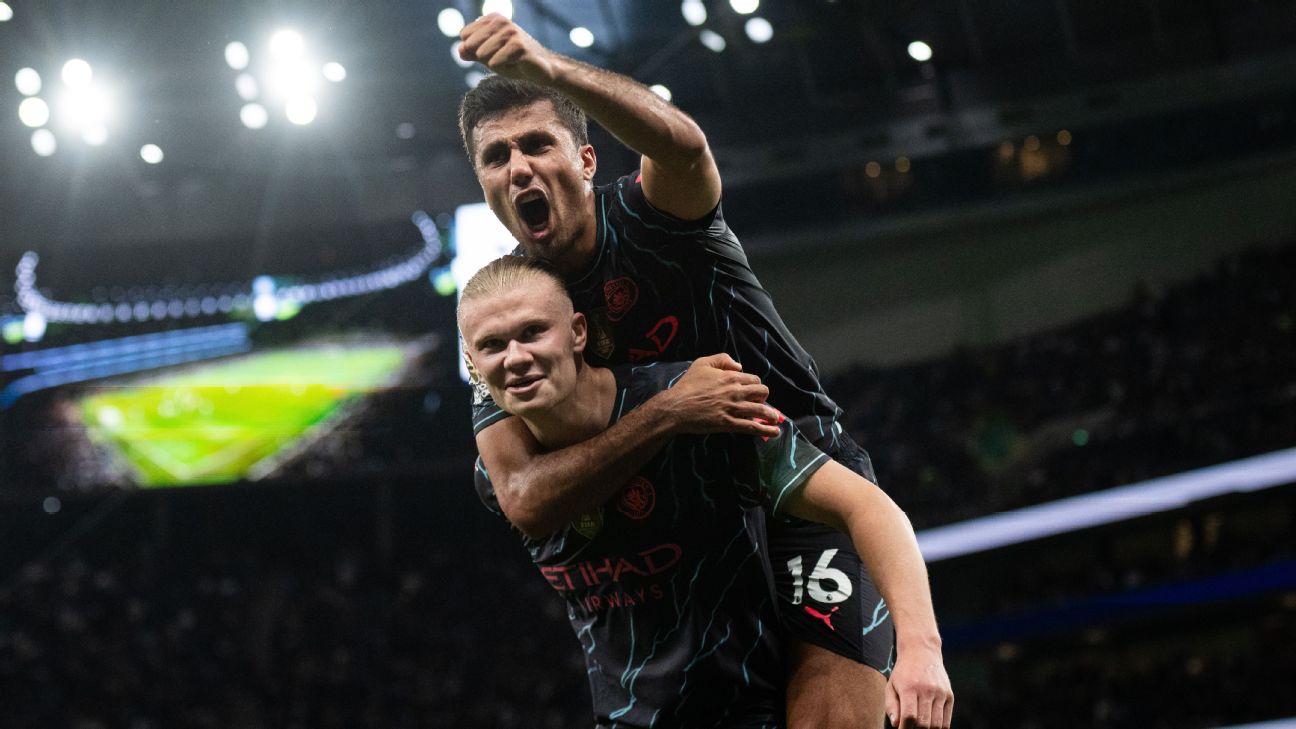You know what’s quite hard? Ranking soccer players. How do I know that? Well, I’ve just done it.
Unlike in baseball, we don’t have a Wins Above Replacement (WAR) number that represents everything a player does on a baseball field and then translates it into the actual value provided to his team. Unlike in American football, we don’t have a clear positional spectrum where quarterbacks are by far the most important players, followed by the players who try to either tackle or protect the quarterback. And unlike in basketball, we don’t have the constant substitutions and scoring that make it relatively easy to see how a team performs when a player is on and off the court.
Instead, it’s just 90 minutes with mostly the same players on the field and barely anything that leads to a point being scored. Good luck deriving any kind of single-number value from that!
Of course, it doesn’t mean we can’t try. There are some substitutions in soccer, and we can look at all shots, not just the ones that go in, to get a bigger sample of events to tie both individual and team performance onto. Plus we know that most of the best players in the Premier League play for Manchester City, Arsenal and Liverpool — both because they’re among the richest teams in the world and because they were so much better than everyone else last season.
A week before the Premier League season kicks off, I’ve ranked who I expect to be the top 50 players in the Premier League this season. What do I mean by “best”? How did the list shake out? And, oh my god, how did you not list the guy from my favorite team over that other guy from the team I hate?
Read on to find out.
A quick note on methodology
This process was part art and part science. I hesitate to even use the word “art” because a good chunk of this exercise included me just squinting at the list and moving names around until I felt good with what I saw, though it’s not totally subjective either.
To come up with an initial ranking, I used a combination of Edvin Hoac’s contextualized plus-minus (CPM) statistic
The model essentially rates players through a combination of their individual stats and the team’s performance with said player on and off the field. It adjusts for team quality and league quality and then estimates a player’s impact on the average team’s performance. This kind of model both rewards players for on-ball individual production and the unseen stuff that leads to winning.
As for why I used Transfermarkt, it’s simple: wisdom of the crowds. The player valuations aren’t a direct proxy for player quality, but they’re close, and they do take into account the player’s age. I didn’t weigh the Transfermarkt values as much as CPM, but my thought was that there is some information hidden within these crowd-sourced numbers. Plus, it adds a bit of a predictive nature to the exercise. If younger players have higher transfer values, then they’ll get a bump in the rankings and vice versa. CPM is a representation of how good a player has been, not how good he’ll be.
I used these two models because I am incapable of watching every movement of every Premier League player in every game. And even if I were capable of that, I don’t think I would also be capable of translating everything I was seeing into some kind of value system that quantified the worth (in terms of wins or points) of what each player was doing. Thanks to its random, low-scoring and unstructured nature, soccer is the most prone to cognitive biases. Therefore it made sense to start with a model, rather than my own impressions, as my baseline.
Then, from those rankings, I slid in a couple players who missed the cut, dropped out a few who didn’t seem to deserve a top-50 spot and then made a couple more minor tweaks to the rankings of a few other players who seemed like they should have been a little higher or lower.
I tried to balance pure talent with the importance of actually playing soccer games, too. There are no playoffs, so every minute missed is a minute where that player isn’t contributing to his team’s chances of finishing higher at the table. At the same time, bigger clubs will rotate players since they have deep rosters and they’re frequently competing across multiple competitions. Like I said: art-ish and science-y!
The result ended up looking like this …
Gab & Juls discuss the top three midfielders on the ESPN FC 100.
![]()
T50. Lisandro Martínez (26 years old), center back, Manchester United
He’s a really good player when healthy, but at 5-foot-9 his lack of ability in the air puts some limits on whatever defense he plays for and requires a certain type of center back partner. Plus, he just hasn’t been healthy. At a position where players don’t get subbed out, Martinez has only played 2,760 minutes across his first two Premier League seasons.
![]()
49. James Maddison (27), attacking midfielder, Tottenham
![]()
48. Jérémy Doku (22), winger, Manchester City
Perhaps the most classic case of “great stats, but might not make his team much better” in the sport right now. On the one hand, he was second in the league in Stats Perform’s possession-value metric, which rewards players based on all of their on-ball actions for how much each action increased or decreased their team’s probability of scoring a goal:
 (Credit: TruMedia)
(Credit: TruMedia)
And that’s despite Doku only playing about 1,600 minutes in the league last season. He’s pretty much a guaranteed path to the penalty area every time he touches the ball; he dominated the European leaderboard for carries into the box despite not even being a full-time starter.
At the same time, City’s play drastically slows down every time Doku touches the ball, and I can’t help but feel that some of his statistical imprint comes from all the space afforded to him because of all the talented City players elsewhere on the field. If he becomes a full-time starter, though, and keeps this up for a full season, he’ll be pushing the top 10 of this list next year.
![]()
47. Kaoru Mitoma (27), winger, Brighton
![]()
46. Diogo Jota (27), forward, Liverpool
Jota was one of only three Premier League players to break the 1.0 mark for non-penalty goals+assists per 90 minutes last season. The only problem: last year was the third time in four tries for Liverpool where he hasn’t even played 1,200 minutes.
![]()
45. John Stones (30), center back, Manchester City
![]()
44. Ibrahima Konaté (25), center back, Liverpool
![]()
43. Lewis Dunk (28), center back, Brighton
We’re analyzing these three — Stones, Konate and Dunk — together and yes, in an ideal world, you’d rather have Stones or Konate.
There’s a decent argument that Stones was the most important player for City in their treble-winning season. If there are other players in the world who could do what he did, well, we haven’t seen anyone else play at a world-class level at both center midfield and center back … in the same game … week in and week out. He was amazing — and then he started 12 Premier League games the following season.
While some central defenders are tough to measure statistically, Konate is not. Among players at his position in the Premier League last season, he ranked in the 99th percentile for progressive passes and the 94th percentile for progressive carries, per FBref. Despite playing for a team with a ton of possession, he ranked in the 81st percentile for combined tackles+interceptions. Oh, and he was in the 99th percentile for aerial duels won and the 91st percentile for aerial duel win rate. Amazing passer, incredible ball carrier, fantastically active defender, and utterly dominant in the air … Konate also only started 17 games last season.
Neither Stones nor Konate have ever even played 2,000 minutes in a season for their current clubs, while Dunk has never played fewer than 2,500 minutes for Brighton over the past 10 seasons, across multiple leagues and managers with varying stylistic demands and while the club have steadily moved up the table.
Would you rather have world-class center back play for a third of a season or above-average Premier League performance for pretty much every minute of every game? We’re going with the latter.
![]()
42. Leandro Trossard (29), forward, Arsenal
![]()
41. Dominik Szoboszlai (23), midfielder, Liverpool
![]()
40. Kyle Walker (34), full-back, Manchester City
![]()
39. Gabriel Jesus (27), forward, Arsenal
Shaka Hislop explains why he’s a fan of Liverpool boss Arne Slot committing to striker Darwin Núñez as a crucial part of the club’s future.
![]()
38. Darwin Núñez (25), forward, Liverpool
![]()
37. Kai Havertz (25), forward, Arsenal
![]()
36. Ollie Watkins (28), forward, Aston Villa
![]()
35. Bryan Mbeumo (24), forward, Brentford
Let’s look at the above five forwards in more detail.
It seems like Arsenal are willing to head into the season with Jesus and Havertz as their starting strikers, and I don’t hate it. They’re two of the best defensive forwards in the world, and they both deserve more credit for why Arsenal have suddenly become arguably the best defensive team in the world. If you look at them as one player, then they gave Arsenal 16 non-penalty goals and 12 assists, plus elite pressing from the front.
Unlike the other three in this little cohort, Núñez could easily be in the top 10 or top five of this list come next season, and he did play over 2,000 minutes last year while averaging 0.84 non-penalty goals+assists per 90 minutes — good enough for eighth best in the league. At the same time, he’s probably a net negative out of possession and in helping Liverpool keep possession. And while it’s unlikely, there’s also a world where he doesn’t even become a consistent starter under Liverpool’s new manager Arne Slot.
Watkins had a career year last season –19 non-penalty goals and 13 assists. His track record of elite-level play isn’t as long as either of the other three forwards here, but he has also played close to 3,000 minutes in each of the past four seasons.
It’s a bit of a projection to have Mbeumo higher than all of the other players, but he has been incredibly productive in a Brentford side that rarely have the ball and simply just don’t have much attacking talent at all. He has contributed in different ways to Thomas Frank’s team in each of his three Premier League seasons, and he’d be the Brentford attacker I’d be targeting, as opposed to his higher-profile teammate, Ivan Toney, if I were a bigger club. He’s the kind of flexible, utility attacker that every team could use.
![]()
34. Enzo Fernández (23), midfielder, Chelsea
![]()
33. Manuel Akanji (29), defender, Manchester City
![]()
32. Eberechi Eze (26), attacking midfielder, Crystal Palace
![]()
31. Alexander Isak (24), forward, Newcastle
Some hack recently wrote about how he could win the Golden Boot. A massive breakout season could be on the cards for Isak this year.
![]()
30. Andy Robertson (30), full-back, Liverpool
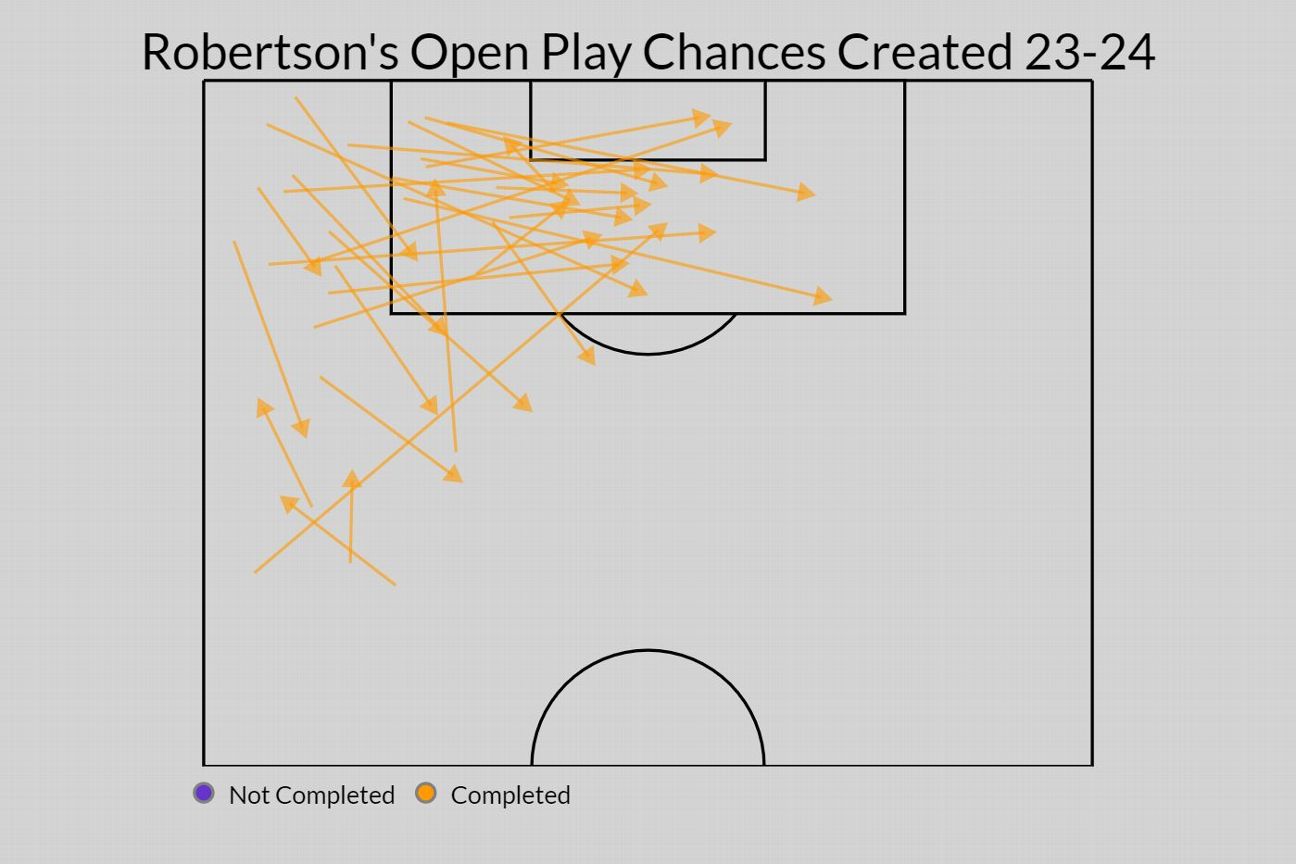
(Credit: TruMedia)
The Scotland international was hurt for much of last season, and he’s now on the wrong side of 30. And yet, he registered more total xG than in any prior season of his career, and his rate of 0.29 expected goals assisted per 90 minutes was also a career best. When he’s healthy, there’s still no better full-back at breaking the defense down with his off-ball movement and quick passing into the box:
It’s just: how many players get healthier after they turn 30?
![]()
29. Luis Díaz (27), winger, Liverpool
![]()
28. Josko Gvardiol (22), defender, Manchester City
![]()
27. Alexis Mac Allister (25), midfielder, Liverpool
![]()
26. Emiliano Martínez (31), goalkeeper, Aston Villa
Across his five Premier League seasons, he has allowed 12.5 goals fewer than expected, based on Stats Perform’s post-shot xG model. Purple are saves, orange are goals:
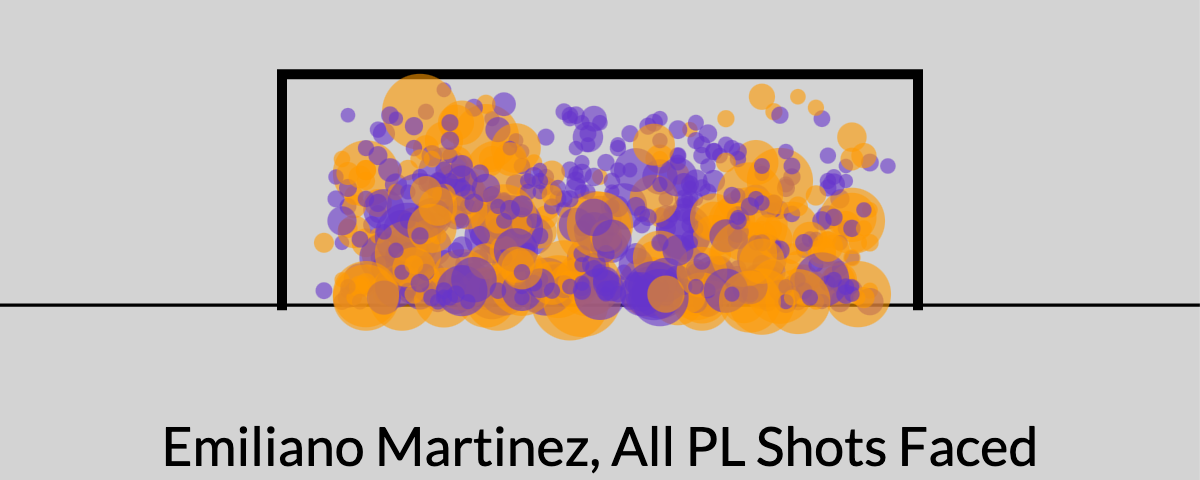 (Credit: TruMedia)
(Credit: TruMedia)
In addition to the shot-stopping, Martinez turned into a functional sweeper-keeper for Aston Villa boss Unai Emery last season and ranked in the 99th percentile among all goalkeepers for the percentage of crosses he claimed. When you play like that, you can talk all the smack you want.
![]()
25. Cristian Romero (26), center back, Tottenham
![]()
24. Nathan Aké (29), fullback, Manchester City
![]()
23. Kieran Trippier (33), fullback, Newcastle
![]()
22. Jack Grealish (29), winger, Manchester City
I might be relying too much on my priors here. Grealish really has had only one good season across the past three years, but he has been both a one-man team for Aston Villa and a key contributor to the greatest club team England has ever produced. Unlike Doku, I’m more confident that Grealish’s playing style contributes to winning at the absolute highest level.
![]()
21. Son Heung-min (32), forward, Tottenham
Are you an aging winger? Are you feeling the effects of an increasingly bloated match calendar? No longer able to beat full-backs to the end line? Are central midfielders preventing you from shifting the ball onto your strong foot and getting to where you want to go? Less energy? Less drive? It’s not your fault. It happens to every man as he ages. But you’re in luck because we’ve found a cure? It’s called: learn how to pass!
It seemed like Son had finally hit the downslope of the age curve in 2022-23, and then he set a career-best mark for xG assisted, tying for the league lead with Bruno Fernandes and Mohamed Salah on 11.8. Combine that creativity with the most ambidextrous finishing ability in the world, and you’ve still got a star player at age 32.
![]()
20. Alisson (31), goalkeeper, Liverpool
He has saved 24 goals more than expected over the past seven seasons, on a diet of some of the most difficult shots in the game. He’s the best in the world.
![]()
19. Ben White (26), full-back, Arsenal
White is pretty much the perfect current-era full-back. He defends like a center back, passes like a central midfielder, but can still overlap when you want him to. I haven’t figured out how to quantify this yet, but I feel like every time White overlaps Bukayo Saka, something good happens. Either defenders follow White and create space for Saka to cut in for a shot or one of those signature dinked balls to the back post, or no one follows White because they’re worried about Saka and the right-back gets the ball in a ton of space near the end line.
These are the passes I’m talking about (inside that dotted line, top right corner):
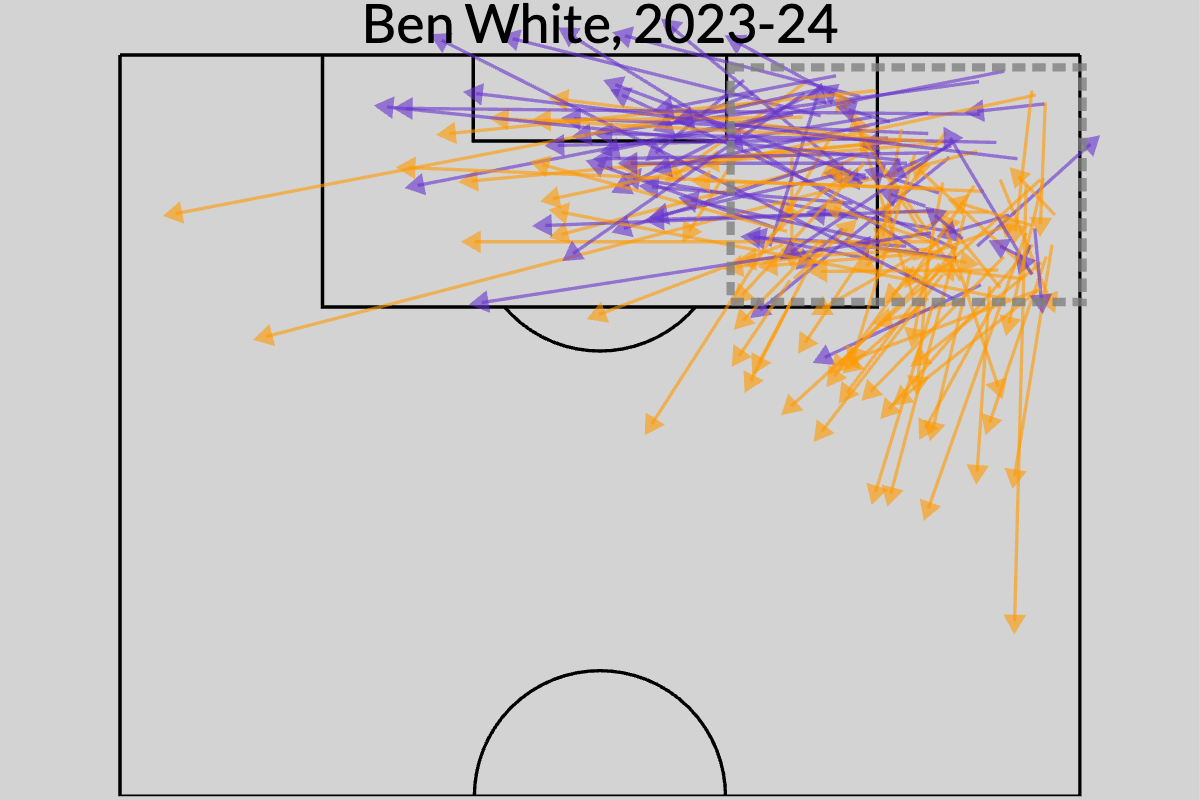 (Credit: TruMedia)
(Credit: TruMedia)
How much does Mikel Arteta love White? Arsenal’s first major signing of the summer was Riccardo Calafiori — the Italian, left-footed version of White.
![]()
18. Gabriel (26), center back, Arsenal
![]()
17. Gabriel Martinelli (23), forward, Arsenal
![]()
16. Bernardo Silva (29), midfielder, Manchester City
![]()
15. Rúben Dias (27), center back, Manchester City
![]()
14. Cole Palmer (22), attacking midfielder, Chelsea
![]()
13. Bruno Fernandes (29), attacking midfielder, Manchester United
![]()
12. Bruno Guimarães (26), midfielder, Newcastle United
![]()
11. Declan Rice (25), midfielder, Arsenal
And here we enter the portion of the programming where every player feels like they’re ranked too low. This isn’t an indictment on Rice in any way. He’s one of the best midfielders in the world. He’s good at … everything? His presence on Arsenal pretty much directly coincided with them going from being a “Hey, that’s fun that they challenged for the title” team in 2022-23 to an “OK, yes, this is genuinely one of the best teams in the world” side in 2023-24.
Rice is a fantastic ball winner. His ball-carrying and his passing get better with each successive season. He’s physically dominant. He never gets injured. He started taking set pieces last year? Oh, and he scored seven goals and added eight assists.
The only warning sign: Rice played over 4,000 minutes last season across all competitions and then spent the entire summer chasing the ball around as England struggled to control games at Euro 2024.
Martin Odegaard speaks about Arsenal’s hopes for the upcoming season under Mikel Arteta.
![]()
10. William Saliba (23), center back, Arsenal
![]()
9. Virgil van Dijk (33), center back, Liverpool
Want to put either of these guys at No. 1? Go for it. They’re the two best center backs in the world, in my opinion, but then why is the old guy ahead of the young guy on the team with a better defense?
At Arsenal, Saliba has protection from a ton of other defensive talent around him, plus an incredibly structured possession system that doesn’t leave its defenders out to dry all that often. At Liverpool, Alexis Mac Allister (uh) was the defensive midfielder, Trent Alexander-Arnold is pretty much allowed to go wherever he wants, Robertson still scorches his way up and down the field, the other center back spot was a revolving door, and the team took a ton of risks in possession, so the ball was constantly being turned over without much defensive structure behind it.
I don’t think Arsenal are worse if you swap Van Dijk for Saliba, and I wouldn’t bet against Saliba dominating in a much more aggressive system, but we’ve simply never seen it. On top of that, VVD’s statistical profile stands out a bit more. He’s a much bigger threat on set plays, he plays more progressive passes, and he’s in the 97th percentile or above for aerial duels won, percent of aerial duels won and percent of dribblers tackled. Saliba is in the 45th, 53rd and 80th percentiles, respectively, of those same stats.
Van Dijk is the best center back I’ve ever seen. Being one spot behind him is still pretty damn good!
![]()
8. Kevin De Bruyne (33), attacking midfielder, Manchester City
So, um, arguably the greatest midfielder of the 21st Century is eighth on this list? I might regret this one. KDB’s per-90 production was still absurd last season; the 1.03 goals+assists per 90 minutes was the best mark of his career. The main reason he’s not higher: he’s 33 and missed half of last season with an injury. Plus, he doesn’t really do any defending anymore, and he hasn’t played 2,500 minutes in any of the past three seasons.
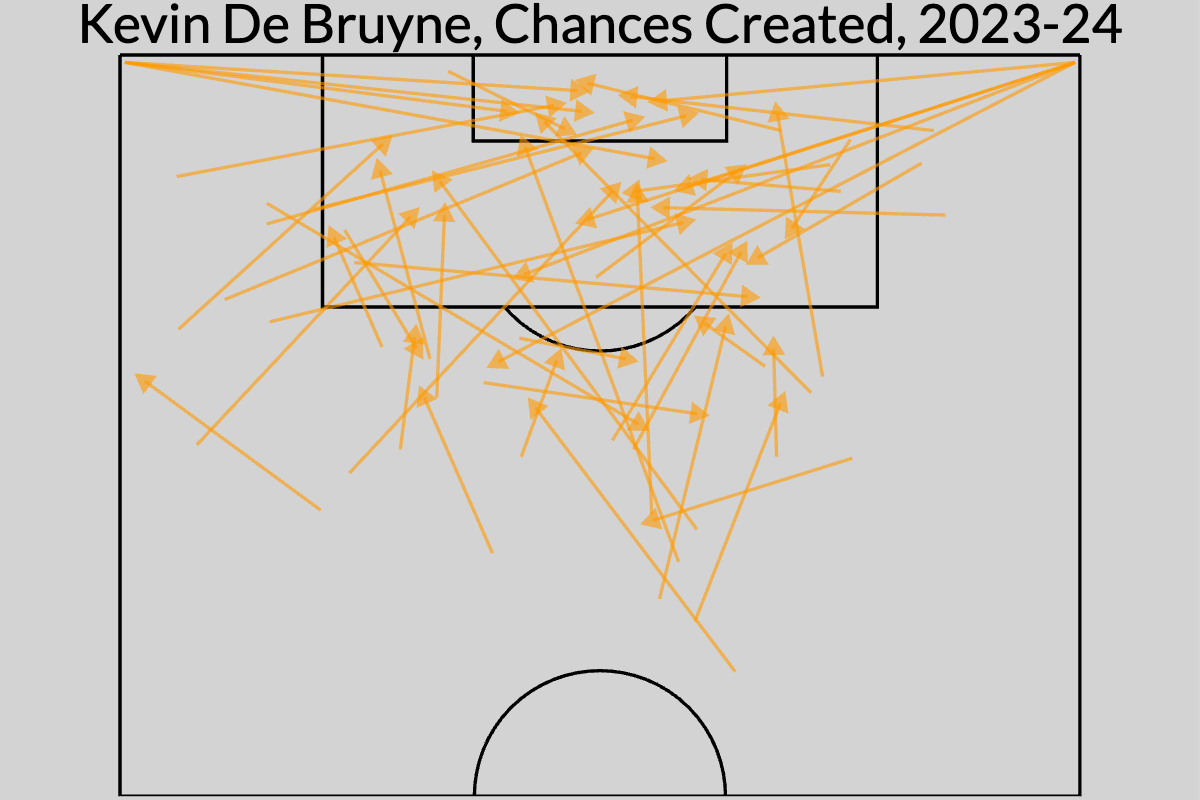 (Credit: TruMedia)
(Credit: TruMedia)
That said, a half season of KDB is still a top-15 player in the league. He started 15 games last season, while only Palmer and Watkins finished the season with more assists.
![]()
7. Trent Alexander-Arnold (25), fullback, Liverpool
Here’s a list of all the players across Europe’s Big Five leagues since 2017 who have progressed the ball with their passing at least 500 yards upfield per 90 minutes and also contributed at least 0.25 xG assisted per 90:
• Cesc Fabregas, Chelsea (2017-18)
• Joshua Kimmich, Bayern Munich (2021-22)
• Trent Alexander-Arnold, Liverpool (2022-23)
• Trent Alexander-Arnold, Liverpool (2023-24)
Yeah, I think we’re going to be just fine with the occasional defensive mishap.
![]()
6. Bukayo Saka (22), winger, Arsenal
![]()
5. Mohamed Salah (32), forward, Liverpool
Once again: both Saka and Salah could easily be No. 1 on the list!
As you saw earlier, Saka provided more possession value than any other player in the league last season. He’s a great defender from the front, he carries the ball upfield as well as anyone and is one of the best off-ball runners in the sport. This is how teams defend the guy:
My point with Saka is: this is the norm. This is how he’s defended every week.
The other norm? He created a great chance out of this. pic.twitter.com/BSH2xscGkN
— Billy Carpenter (@billycarpy) May 7, 2024
The only reason I have Salah slightly above him is the creation of chances around the goal. Salah is a three-time Golden Boot winner, and ranked second in the league last season in non-penalty xG+xA per 90 minutes: 0.98, slightly behind KDB and slightly ahead of Erling Haaland. Saka still has never been above 0.65, which was the mark he posted last season.
If you want to get even nerdier about it: Saka created around 8.5 goals worth of possession value with all the non-shot stuff, while Salah was at 6.3. Add in shots: 15.5 non-penalty xG for Saka, 10.8 for Salah, and the Egyptian still gets the slight edge — for now. Saka has improved with every season, and I’d expect more of the same in 2024-25.
![]()
4. Phil Foden (24), attacking midfielder/winger, Manchester City
In a season when three teams played at a level that’s usually good enough to win the title, the single most decisive factor in who won the league might have been Foden’s ability to turn his shots into goals. His attempts were worth 10.3 xG last season, and he finished the year with 19 goals:
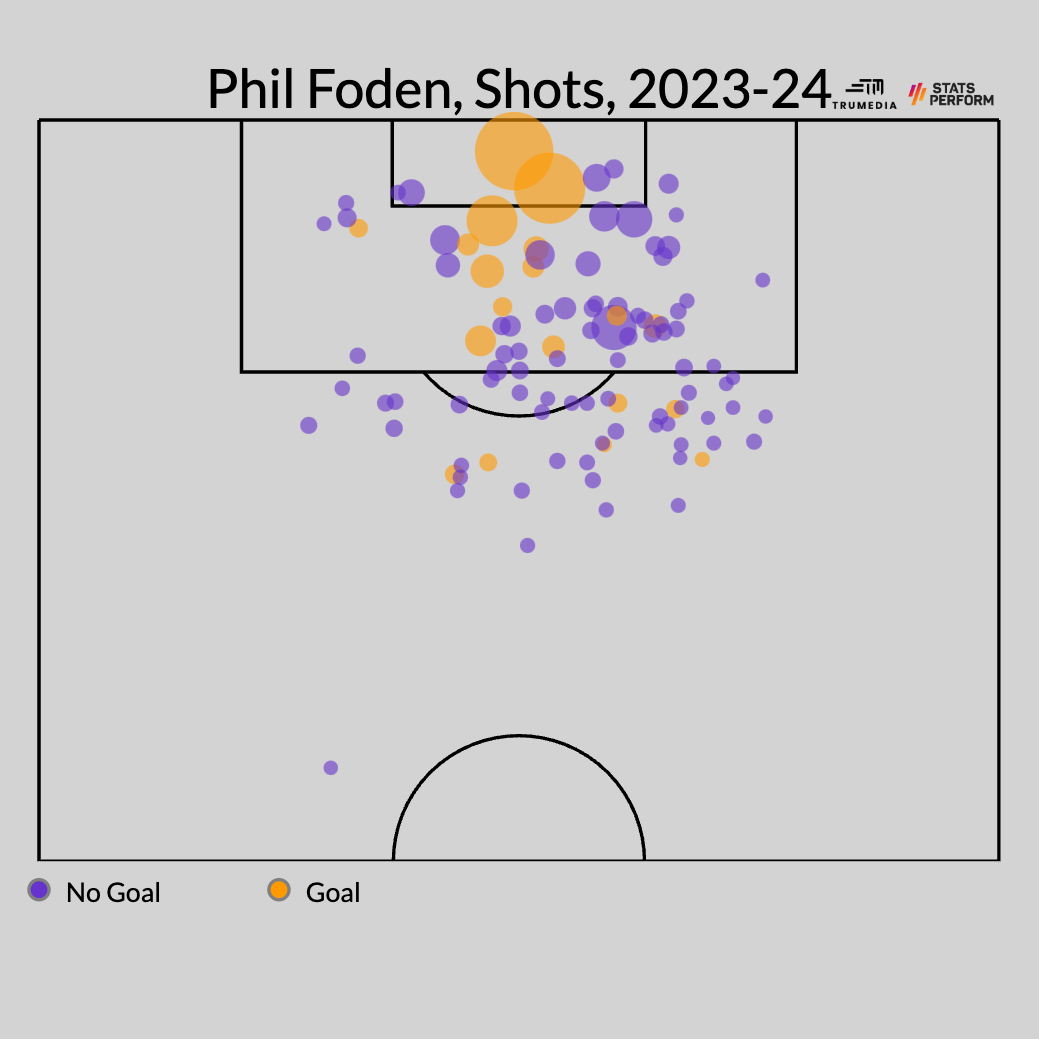 (Credit: TruMedia)
(Credit: TruMedia)
He smashed his xG by 8.7 goals; no one else in the league exceeded the quality of their shots by more than 5.3.
Now, I wouldn’t expect that to happen again, but Foden has outshot his xG by 17-plus goals so far in the Premier League. That’s a big enough chunk of shots to feel somewhat confident in saying that he’s an above-average finisher.
What am I getting at? In terms of pure skill with a soccer ball, Foden might be the best in the world now that Al Hilal’s Neymar is not playing at the highest level anymore. And despite all the calls for him to play as a roaming creative midfielder for England during Euro 2024, that’s not at all who he is. He’s a tactically brilliant midfielder/winger hybrid who finds space in the tightest areas of the field and then creates shots for himself and his teammates, over and over again.
![]()
3. Martin Ødegaard (25), attacking midfielder, Arsenal
Among players classified as either central midfielders or defensive midfielders by Stats Perform, Ødegaard added the second-most possession value … of anyone in Europe last season:
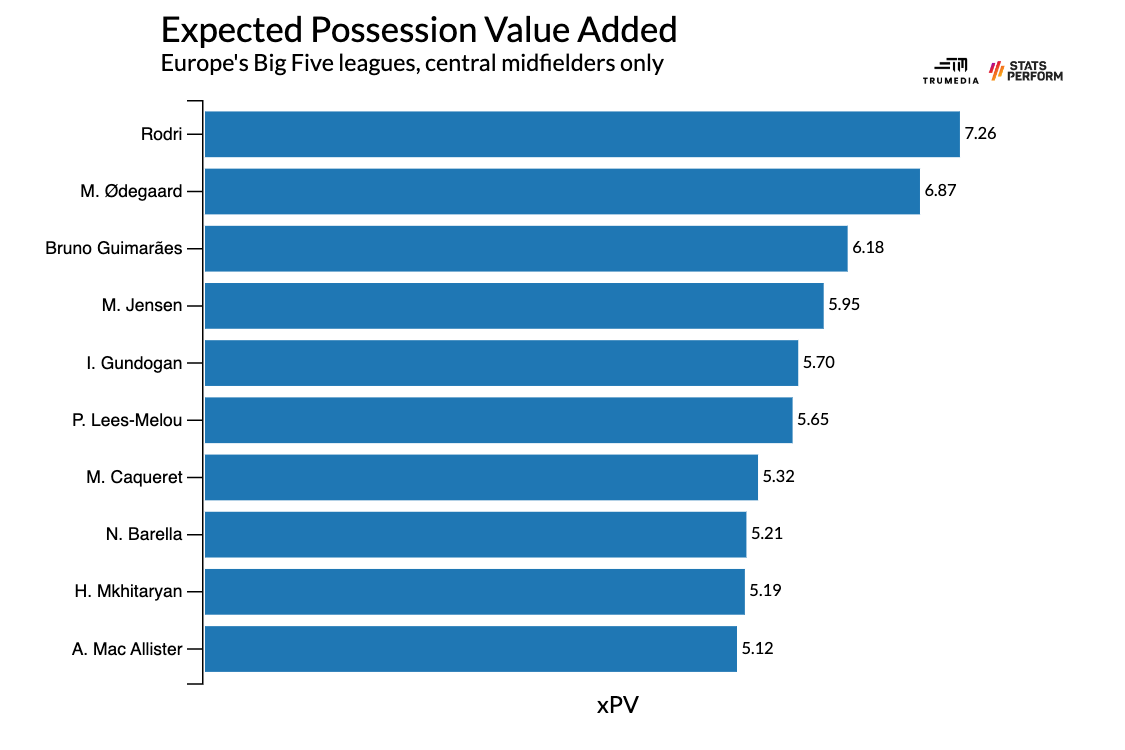 (Credit: TruMedia)
(Credit: TruMedia)
The Norway midfielder completed 39 through balls last season; no one else in Europe had more than 30. He played 130 passes into the penalty area last season; no one else had more than 89. And while he doesn’t register many tackles or interceptions, he’s one of the best pressers at his position in the world.
Arsenal have built a team that prioritizes relatively safe possession, and so the team is filled with players who don’t lose the ball. On the spectrum of great passers, these are mostly players who complete high-probability passes at an even higher rate than average. While City and Liverpool are filled with visionary creative passers, Ødegaard is the only Arsenal player who is consistently tasked with unlocking opposition defenses with a pass.
Normally, you see outsize passing numbers like these when a team is overly reliant on a single player to keep it afloat. This is the case with Manchester United’s Fernandes, who ranked second behind Ødegaard in both through balls and passes into the box. But with Ødegaard as a one-man passing machine, Arsenal weren’t scrapping for a UEFA Europa League spot. No, they were one of the best teams in the world.
![]()
2. Erling Haaland (24), forward, Manchester City
I thought about getting cute with this. He doesn’t contribute much in possession! Does he even know how to press? Have Manchester City even really been that much better since he joined the team?
And then I looked at this chart:
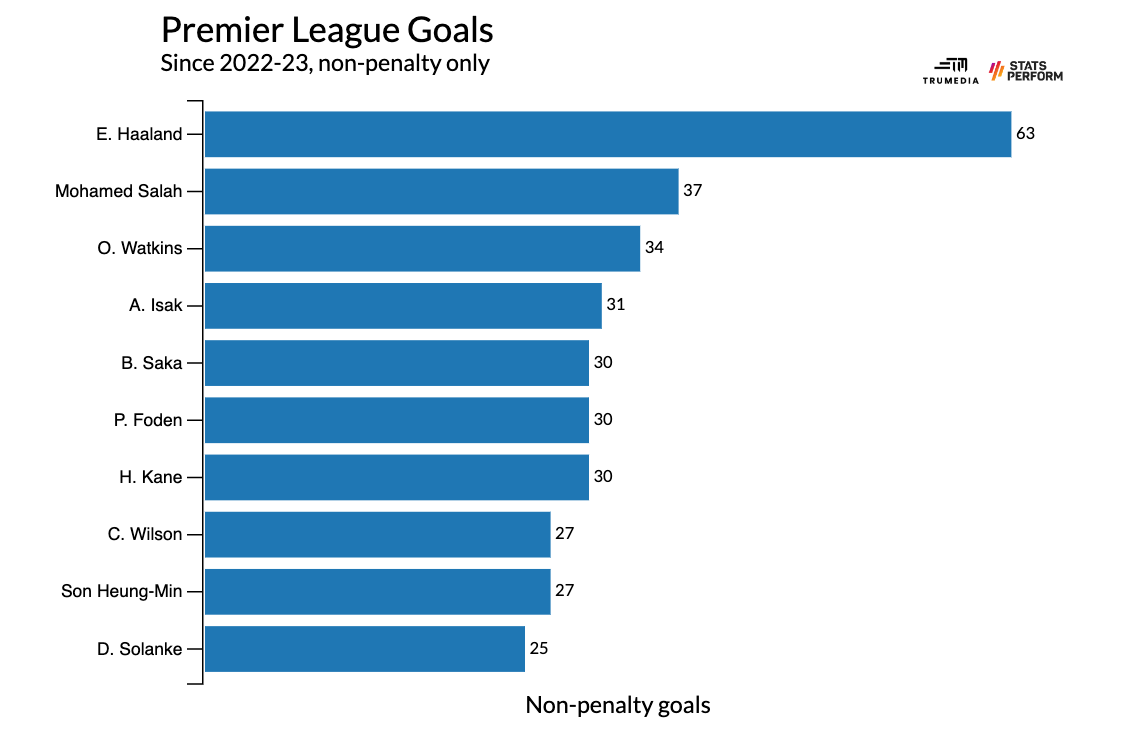 (Credit: TruMedia)
(Credit: TruMedia)
The scariest part, among many scary parts: he only turned 24 a couple of weeks ago.
![]()
1. Rodri (28), midfielder, Manchester City
I picked him to win the Ballon d’Or. Who else did you expect?
